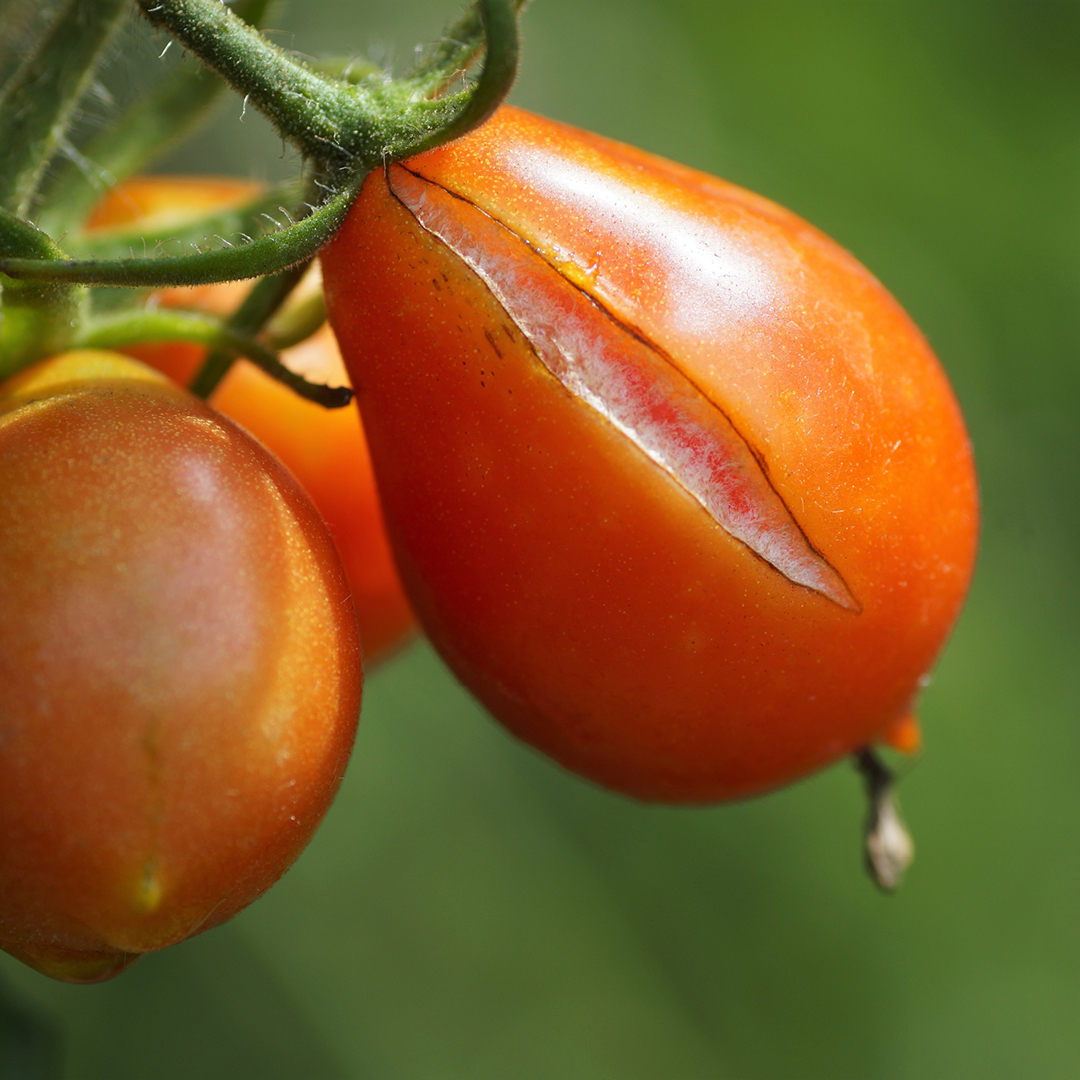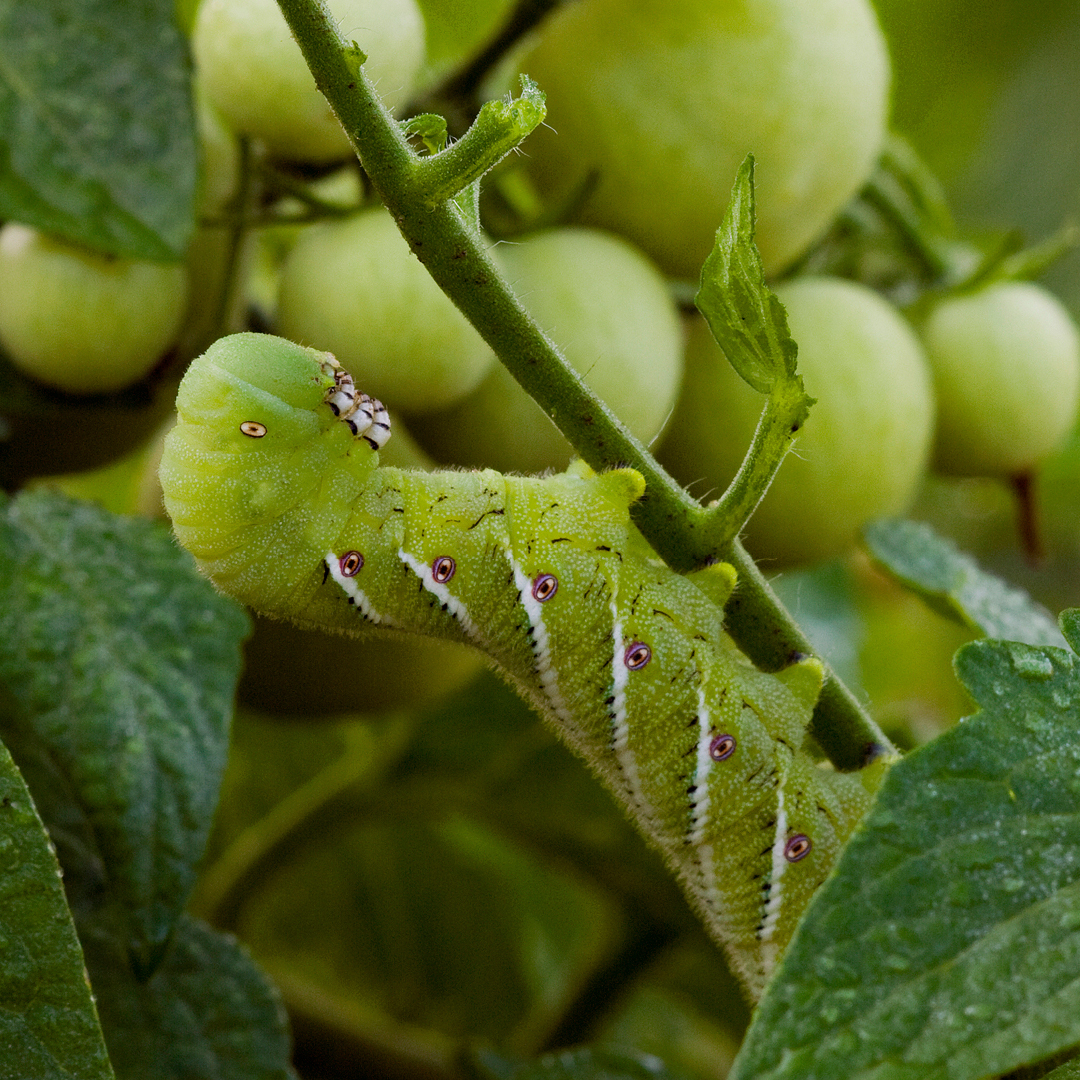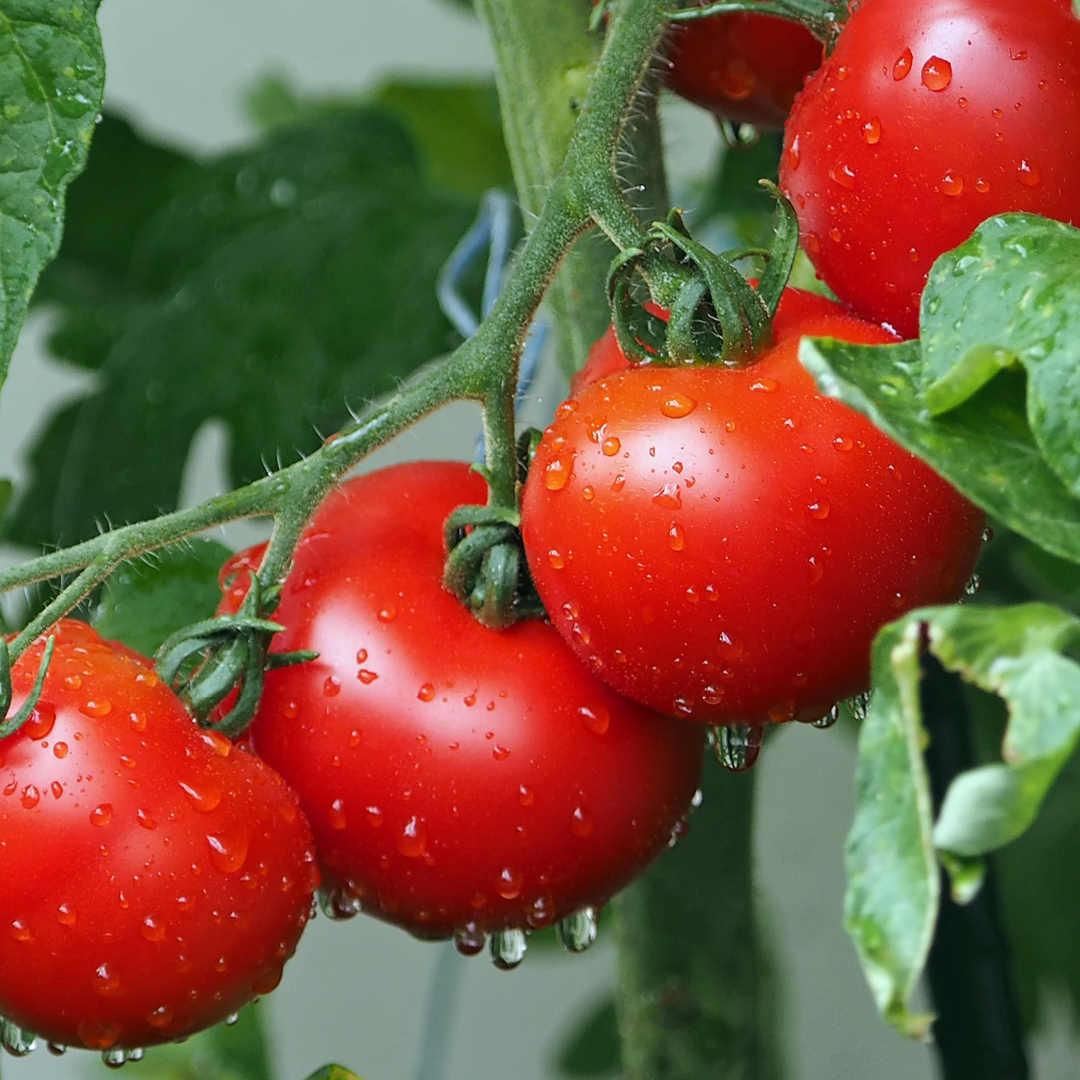As a Tucson vegetable gardener, you’re in luck because it’s the perfect time to start thinking about and growing your tomatoes! Little is as satisfying as enjoying a delicious, ripe, red, juicy, fresh tomato directly from the garden. Not only are tomatoes delicious, they are packed with essential vitamins and nutrients. With so many different varieties to choose from, you can grow cherry tomatoes for snacking, unusual-colored fruits to impress your friends, or the perfect slicing tomato for sandwiches and salads. However, our Tucson soil and climate can make tomato growing a little bit tricky. Here are some problems that you may encounter and how to resolve them. We hope to empower you to be successful as you grow more and more vegetables in your home garden.
Catfacing
Tomato catfacing is not an uncommon issue that vegetable gardeners encounter. Catfacing refers to the distortion of the tomato fruit, resulting in a misshapen or lumpy appearance. It occurs due to abnormal cell division during the early stages of fruit development. Although it doesn’t affect the fruit’s taste, it makes it less visually appealing and sometimes results in a smaller yield.
To resolve the problem of catfacing tomatoes, gardeners can adopt some measures. One of the first steps to implementing measures to prevent this problem is to choose the right varieties of tomatoes to plant. Varieties less susceptible include ‘San Marzano,’ ‘Roma,’ and ‘Celebrity.’ When planting, make sure the soil moisture levels are consistent, as water fluctuations can exacerbate the issue. Also, providing regular irrigation helps reduce stress on the plant and the fruit.
Another method of prevention is to maintain consistent temperatures in the growing area. Arizona’s desert climate is known for its high temperatures, which fluctuate significantly in summer. When temperatures are consistently above 90°F, tomatoes’ growth rate slows down, leading to cat facing. To regulate the temperature, gardeners can provide shade to cover the plants during the hottest hours of the day.
Curley Top Virus
Tomato Curley Top Virus is a devastating disease that can affect tomato plants. This virus is primarily transmitted through the feeding of the beet leafhopper, which is a tiny insect found in the region. The virus causes the plant to develop curly top leaves, twisted stems, stunted growth, and, in severe cases, wilting. Infected plants may also produce small, underdeveloped, and bitter fruit.
Unfortunately, there is no cure for Curley Top Virus, and once the plant is infected, it must be removed and destroyed to prevent the further spread of the virus.
Cracking Fruit
Another problem veggie gardeners may face is cracking fruit, which can make it difficult to harvest and enjoy the tomatoes they’ve worked so hard to cultivate.
Cracking fruit in tomatoes can occur due to various factors, including rapid changes in temperature, uneven watering, and timing of fertilization. Furthermore, certain varieties of tomatoes are more prone to cracking than others. The skin of a tomato cannot expand as quickly as the flesh, making it vulnerable to cracking when exposed to sudden changes in conditions. When the weather is hot or dry, and the soil is not provided with adequate moisture, the tomatoes can become thirsty, leading to cracking fruit.
Various steps can be taken to resolve this problem. Firstly, ensuring the fruits receive sufficient water regularly, particularly during hot spells, can help prevent cracking. Secondly, avoiding over-fertilizing the plant can prevent sudden growth spurts that could lead to cracking. Additionally, avoiding sudden environmental changes by providing shade or a layer of mulch around the tomato plants can also help.
Blossom Drop
Tomato Blossom Drop is a condition that occurs when the tomato plant cannot hold its flowers, causing them to drop prematurely. The flowers of the plant are essential for the formation of fruits. Hence, if they are not able to set, it can lead to a reduced yield.
Several factors can cause Tomato Blossom Drop. High temperatures, lack of water, and extreme humidity can hinder the plant’s ability to hold its flowers. Furthermore, poor soil quality, excessive use of nitrogen-rich fertilizers or insecticides, and inadequate pollination can also contribute to this condition.
Fortunately, gardeners can take several measures to prevent and resolve Tomato Blossom Drop. The first step is to maintain a consistent water supply for the plants, ensuring they are neither overwatered nor underwatered. Additionally, gardeners can opt for drip irrigation or soaker hoses to water the plant’s base, avoiding water on the foliage.
Providing shade to the plants during the hottest part of the day can also help prevent this problem. Using mulch can regulate the soil temperature, reducing the risk of the plant overheating. With adequate pollination being a key to the formation of fruits, gardeners can take steps to attract pollinators, like planting flowers that attract bees.
Lastly, gardeners should keep an eye on the soil quality. Maintaining a balance of nutrients, avoiding excessive use of nitrogen-rich fertilizers, and applying organic fertilizers can promote healthy plant growth and help prevent Tomato Blossom Drop.
Blossom End Rot
Blossom End Rot is a common problem that plagues a number of vegetables. Black, sunken patches at the blossom end of the tomato fruit characterize this disease. It is a result of calcium deficiency, which causes the cells in the affected area to break down and rupture. This problem primarily affects tomatoes but can also occur in other vegetables such as peppers, eggplants, squash, and more.
Various factors can cause Blossom End Rot. The disease can occur due to a lack of calcium in the soil, fluctuations in soil moisture levels, low soil pH levels, and high temperatures.
There are several ways to resolve this issue. One solution is to maintain adequate soil moisture levels by watering thoroughly and regularly, especially during the dry seasons. Additionally, it is crucial to monitor the garden’s soil pH levels and adjust them accordingly, which can be done using lime or other appropriate soil amendments. Furthermore, it is essential to provide the plant with enough calcium by incorporating calcium-rich fertilizers, such as bone meal or calcium nitrate, into the soil. Lastly, shade covers can provide protection against extreme heat, which can trigger a calcium deficiency in the plant.
Foliage but no Fruit
Tomato vines are known for their lush green foliage and juicy red fruits. However, it can be frustrating for gardeners when the vines produce abundant foliage but no fruits.
One of the main reasons for this is a lack of pollination. Tomatoes require pollination to produce fruit, and if there are no pollinators, such as bees, in the area, then the plant will not produce any fruit. So, if you are not seeing any bees around your vegetable garden, you can tap the flower stalk with your finger to pollinate the flowers or introduce some pollinators. You can do this by adding some bee-attracting flowers, planting native plants, and installing a bee hive.
Another reason for the lack of fruit is poor soil quality. Tomatoes require nutrient-rich soil to grow properly, and if the soil is depleted, it can hinder their growth. In Tucson, the soil is often sandy and, therefore, low in nutrients. Gardeners can add compost or fertilizer to the soil to improve its quality. It is also necessary to ensure that the soil is well-drained, as water-logged soil can inhibit the growth of tomato plants.
Furthermore, pruning is an essential part of growing healthy tomato plants. Overgrown plants with too many leaves will divert energy away from producing fruit. Pruning helps the plants to focus their energy on producing fruit instead of foliage. Remove excess leaves any suckers that develop between the main stem and branch.
Tomato Hornworm
Tomato Horn Worms are a notorious pest! These large, green caterpillars are voracious eaters, and they can quickly decimate entire tomato plants in just a few days, leaving behind barren stems and wilted leaves.
If left unchecked, Tomato Horn Worms can cause extensive damage to other garden vegetables, such as eggplants, peppers, and potatoes. Moreover, the silvery-green droppings that they leave behind can lead to secondary infections and bacterial growth, making the affected plants more susceptible to other diseases.
Fortunately, several organic pest control methods, such as B.T., can effectively eliminate Tomato Horn Worms from the garden. Another approach is to handpick the caterpillars from the plants and dispose of them in a bucket of soapy water or place them on a different, sacrificial, plant. Additionally, introducing natural predators such as parasitic wasps and braconid flies can help keep the pest population in check.
Another approach is to spray the plants with a solution of neem oil and garlic, which repels the caterpillars and disrupts their feeding patterns. Neem oil contains azadirachtin, a natural pesticide that targets the nervous system of insects, leading to their death.
Planting companion plants like basil, and marigold can also help repel this pest from the garden. These plants have strong odors that mask the scent of the host plant, making it difficult for the caterpillars to locate them.
Zippering
Tomato Zippering is an issue that usually manifests in the form of long, narrow scars that appear on the skin of ripening tomatoes, resembling a zipper. These scars may begin as tiny, raised blemishes and can grow to a few inches in length, occasionally resulting in the misshapen and malformed appearance of the fruit.
The cause of this issue is still not fully understood, but it is believed to be affected by several variables, including temperature fluctuations, poor pollination, and inconsistent watering. These lead to the fruit’s skin splitting and causing cracks that expose the inner flesh, which merge to create the zipper pattern. It is, however, not harmful to eat tomatoes affected by this, but they may require additional prep before cooking, such as removal of the affected area.
To solve this problem, gardeners in Tucson should maintain consistent watering practices and ensure that the soil is not allowed to dry out completely. This includes watering plants at their base rather than spraying water directly onto the fruit. Additionally, pruning branches and leaves to ensure adequate sunlight exposure will help with the ripening and overall health of the plant. Good pollination can be achieved through various methods, such as introducing bees or hand-pollinating the plants.
Another helpful solution is choosing to plant tomato cultivars that are less prone to zippering. The best cultivars for the Tucson area are those known to be heat and drought-tolerant with strong disease resistance. Further, some gardeners prefer to cover their plants with shade cloth or use a portable shade to minimize temperature fluctuations, which could exacerbate the issue. Additionally, helper nutrients such as potassium, magnesium, and calcium can be added to the soil through fertilizers and manure, which also assists with the development of stronger fruit cell walls and a more desirable texture.
In conclusion, there is a solution to most tomato pests and diseases that can be resolved through pollination, good soil, adequate nutrition, appropriate watering, and good pruning practices. However, it all begins with selecting suitable cultivars for the Tucson garden. Green Things’ knowledgeable staff can help identify and resolve your tomato issues and suggest the best varieties for your veggie garden.


